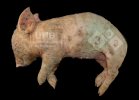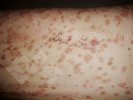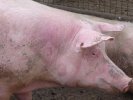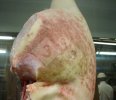Exudative Epidermitis
Caused by the bacteria Staphylococcus hyicus, which invades damaged skin, causing cutaneous infection with eczema or humid dermatitis in lactating piglets and weaners.
Alternative names: Staphylococcus hyicus, Greasy pig disease
Information
Caused by the bacteria Staphylococcus hyicus, which invades damaged skin, causing cutaneous infection with eczema or humid dermatitis. The condition affects mainly pigs 8 weeks or younger. In piglets the disease is presented individually, but can be a severe problem in weaners from farms that have high number of first parity sows. During the days previous to farrowing, the bacteria multiplies in the sows’ vagina, thus, piglets are infected at birth or right after it.
Symptoms
Sows
-
Rare
Lactating piglets
- Severely infected piglets die.
- Lesions are located in the flanks and behind the ears. They start as small dark areas around the face or in the limbs.
- The skin surrounding flanks, stomach and between extremities gradually changes to brown color, affecting all the body.
- Big skin areas get wrinkled and peeled off. They are greasy.
- In more severe cases the skin turns black due to necrosis, and the piglets die.
- If the sow transmits immunity to the piglets, a more located disease is presented, with small circular lesions with a diameter of approximately 5 to 10 mm that do not extend.
Weaners and growers
- Normally symptoms start 3 days after weaning with brown infectious areas around head or limbs, where the skin has been damaged. These lesions can ulcerate.
- The skin surrounding the flanks, the abdomen and between the limbs changes to brown color, and gradually affects the whole body.
- Big body areas of the skin wrinkle and peel off.
- It progresses until a greasy texture is reached and in severe cases these areas turn black.
- Can affect 15% of weaned pigs.
- Dehydration is frequent.
Causes / Contributing Factors
- Teeth clipping incorrectly performed at birth.
- A possibility can be that teeth damage the skin surrounding the mouth while the piglets compete for a nipple.
- Lesions in knees caused while piglets are drinking milk.
- Lesions produced by concrete flooring on poor condition or rough metal flooring, lateral panels and metal feeders in poor condition.
- Fights and skin traumas when animals are weaned.
- Skin damages produced by mange.
- Wounds in face due to metal feeders.
- Low colostral protection due to high number of 1st parity sows.
Diagnosis
Based in characteristic skin lesions. It is important to make cultures of the organism and perform an antibiogram. Samples should be taken from a humid area; peel off the crust and take the sample from the area below it. It must be differentiated from other dermatitis conditions.
Control/Prevention
- Isolate infected animals to avoid transmission.
- Inject affected pigs with an antibiotic effective against the microorganism.
- Bath the piglets using a variety of disinfectants (chloride, chlorhexidine, iodine, etc.).
- Piglets get dehydrated, thus, they need oral electrolytes.
- In severe outbreaks, autogen vaccines might be prepared, and the sows can be injected twice, 4 and 2 weeks before farrowing to increase colostrum immunity.
- Control environmental humidity.
- Minimize crowding in barns.
- Prevent traumas or damage in piglets’ skin.
Atlas of pathology
See images in the Altlas related to Exudative Epidermitis
















